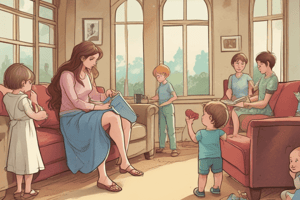Podcast
Questions and Answers
Which parenting style is characterized by very strict rules and controlling behavior?
Which parenting style is characterized by very strict rules and controlling behavior?
- Dictatorial (correct)
- Permissive
- Democratic
- Passive
What type of parenting style allows children to set their own rules?
What type of parenting style allows children to set their own rules?
- Dictatorial
- Permissive (correct)
- Passive
- Democratic
At what age does a child's normal temperature reach 98.6 degrees?
At what age does a child's normal temperature reach 98.6 degrees?
- 5 years old (correct)
- 7 years old
- 1 year old
- 3 years old
What is the typical pulse rate for an infant?
What is the typical pulse rate for an infant?
The Moro reflex is present from birth to ______ months.
The Moro reflex is present from birth to ______ months.
How many deciduous teeth should an infant have by one year of age?
How many deciduous teeth should an infant have by one year of age?
Match the cranial nerve with its function:
Match the cranial nerve with its function:
The anterior fontanel closes between 6 and 8 weeks.
The anterior fontanel closes between 6 and 8 weeks.
What is the typical growth rate of an infant for the first 6 months?
What is the typical growth rate of an infant for the first 6 months?
When do the first teeth usually erupt?
When do the first teeth usually erupt?
Flashcards are hidden until you start studying
Study Notes
Parenting Styles
- Dictatorial/Authoritarian: Strict, controlling parents with rigid rules (e.g., no TV on school nights).
- Permissive: Laid-back parents who allow children to set rules and participate in decision-making (e.g., child decides if they can watch TV).
- Democratic/Authoritative: Balanced approach with set rules explained to the child; uses negative reinforcement for rule deviations (e.g., limited TV time if homework is completed).
- Passive Parents: Indifferent and uninvolved; do not consult or engage emotionally with children.
Physical Assessment Findings
- Pediatric vital signs differ from adults, except for blood pressure.
- Normal temperature: 99.9°F for a one-year-old; reaches normal (98.6°F) by age 5.
- Pulse rate: 80-180 bpm for infants; Respiratory rate: 30-35 breaths per minute.
- Infant blood pressure: Systolic 65-80 mmHg; Diastolic 40-50 mmHg.
- Fontanels: Should be flat and soft; posterior fontanel closes 6-8 weeks, anterior fontanel closes 12-18 months.
- By one year, infants typically have 6-8 teeth; ultimately, they will have 20 deciduous teeth and 32 permanent teeth.
Reflexes
- Moro Reflex: Birth to 4 months; arms and legs extend symmetrically when head/trunk falls backwards.
- Rooting Reflex: Birth to 4 months; turning head toward stimulus on cheek/edge of mouth.
- Palmar Grasp Reflex: Birth to 3 months; infant grasps an object placed in palm.
- Plantar Reflex: Birth to 8 months; toes curl down when sole of foot is touched.
- Startle Reflex: Birth to 4 months; loud noise causes arms to abduct and hands to clench.
- Tonic Neck Reflex: Birth to 3-4 months; extending arm and leg on side toward which head is turned.
- Babinski Reflex: Birth to 1 year; stroking sole causes toes to fan upward and outward.
- Stepping Reflex: Birth to 4 weeks; infant makes stepping movements when feet touch surface.
Cranial Nerves
- CN I: Olfactory (smell)
- CN II: Optic (vision)
- CN III: Oculomotor (eye movement)
- CN IV: Trochlear (down and inward eye movement)
- CN V: Trigeminal (facial sensation)
- CN VI: Abducens (lateral eye movement)
- CN VII: Facial (facial symmetry and movement)
- CN VIII: Vestibulocochlear (hearing)
- CN IX: Glossopharyngeal (gag reflex)
- CN X: Vagus (swallowing)
- CN XI: Spinal Accessory (shoulder movement)
- CN XII: Hypoglossal (tongue movement)
Physical Development
- Infant weight doubles by 6 months and triples by 1 year.
- Growth: 2.5 cm (1 inch) monthly for the first 6 months; length increases by 50% by 12 months.
- First teeth usually erupt between 6-10 months.
Gross and Fine Motor Skills by Age
- 1 month: Head lag; strong grasp.
- 2 months: Lifts head when prone; open hand position.
- 3 months: Raises head and shoulders; no longer grasps reflexively.
- 4 months: Rolls from back to side; grasps with both hands.
- 5 months: Development of other motor skills (not detailed).
Studying That Suits You
Use AI to generate personalized quizzes and flashcards to suit your learning preferences.





